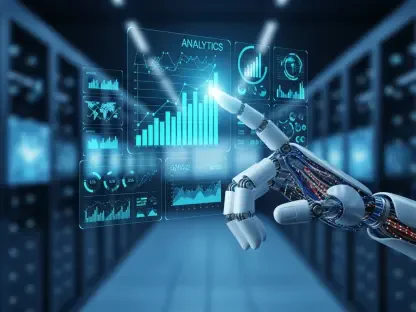In an era where software delivery speed and reliability define competitive advantage, DevOps teams grapple with a staggering reality: nearly 30% of their time is consumed by manual, repetitive tasks, translating to millions in wasted resources annually for organizations with sizable engineering teams. The emergence of Artificial Intelligence (AI) as a tool to alleviate this burden marks a pivotal shift in the industry. This review delves into how AI is reshaping DevOps, examining its capabilities, real-world impact, and the challenges that still linger in its adoption.
Core Features and Capabilities of AI in DevOps
Incident Response and Accelerated Resolutions
AI’s ability to enhance incident response stands out as a cornerstone of its value in DevOps. By correlating logs and metrics, AI systems can slash mean time to resolution (MTTR) by 20% to 40% in environments with robust instrumentation. Such systems identify related incidents and suggest proven runbooks, sparing engineers hours of manual troubleshooting.
However, effectiveness hinges on the quality of data. Environments with inconsistent telemetry often see diminished returns, with MTTR reductions capping at around 25%. Clean, labeled datasets remain a critical prerequisite for unlocking AI’s full potential in this domain.
Compliance Automation for Efficient Audits
Another significant feature lies in AI’s capacity to streamline compliance processes. Automated evidence collection can map infrastructure to frameworks like SOC 2, reducing audit preparation time from weeks to mere days. This efficiency addresses a major pain point, as over 60% of surveyed DevOps leaders cite compliance complexity as a top operational burden.
Despite these advancements, automation does not fully replace human oversight. Auditors still demand manual review for access controls and data-handling practices, meaning AI simplifies evidence gathering but cannot stand alone in attestation processes.
Drift Detection for Enhanced Reliability
AI also excels in drift detection, offering immediate reliability gains by identifying configuration mismatches within minutes rather than through labor-intensive daily checks. The binary nature of success criteria—whether configurations match or not—makes this use case particularly reliable.
Additionally, drift detection requires minimal business context and directly correlates with uptime, driving rapid adoption among teams. This feature consistently delivers measurable returns, positioning it as one of AI’s most dependable applications in DevOps.
Performance and Real-World Impact
AI’s integration into DevOps workflows is not merely theoretical; it has tangible effects across industries, especially in startups and mid-market SaaS companies. Teams leveraging AI in incident response, compliance, and drift detection report significant efficiency gains, with top performers embedding AI directly into CI/CD pipelines and observability systems for optimal results.
Beyond specific workflows, AI is reshaping operational priorities. A notable 67% surge in AI investment over recent years reflects a broader industry shift toward automation as a means to boost developer productivity and cut infrastructure costs. This financial commitment underscores AI’s growing role in achieving faster, more reliable software delivery.
The rise of AI agents, which observe, decide, and act in real time with built-in controls like role-based access and audit logs, further amplifies impact. Nearly 80% of surveyed leaders express openness to adopting these agents, provided they integrate seamlessly and maintain transparency, highlighting a trend toward execution over mere recommendation.
Challenges Hindering AI Adoption in DevOps
Despite its promise, AI in DevOps faces notable obstacles. Anomaly detection systems, for instance, often generate false positives at a rate of 15% to 25% during early deployment, leading to alert fatigue and eroding team confidence. Mitigation strategies such as shadow mode testing and human approval for automated remediation are essential to curb these issues.
Cost optimization represents another area where AI falls short. While algorithms can identify trends like idle resources, they frequently lack business context, risking recommendations that compromise disaster recovery or burst capacity. Human validation remains crucial to prevent unintended outages or compliance lapses.
Fragmented implementation also poses a challenge, particularly in script-driven or partially automated environments where AI can amplify existing inefficiencies. Achieving a higher level of DevOps maturity, with proactive monitoring and policy-as-code foundations, is necessary to maximize returns on AI investments.
Future Trajectory and Emerging Trends
Looking ahead, AI’s trajectory in DevOps points toward deeper integration with live infrastructure data to enhance context and accuracy. Connecting AI to real-time systems like IaC and observability platforms promises more precise actions and resolutions, addressing current limitations in vague or inactionable responses.
Investment trends further signal a long-term commitment, with budgets shifting from manual execution to automation architecture. This evolution suggests that AI will increasingly enable teams to focus on design and reliability rather than repetitive tasks, provided stronger governance and automation maturity are established.
The potential for AI to reduce manual toil from 30% to 20% offers a compelling vision for operational efficiency. As the technology matures, its role as an amplification tool—augmenting human judgment rather than replacing it—will likely define its lasting impact on the DevOps landscape.
Final Assessment and Next Steps
Reflecting on this evaluation, AI proves to be a valuable ally in DevOps, incrementally reducing manual workloads and enhancing key workflows like incident response and compliance. Its performance in well-instrumented environments underscores significant efficiency gains, though challenges like false positives and contextual gaps temper its early success.
Moving forward, teams should prioritize building automation maturity before layering in AI, starting with a single high-friction workflow such as drift detection. Piloting with clear success metrics, ensuring human oversight, and scaling only after proven results will help navigate initial hurdles. By focusing on integration with live data and maintaining robust guardrails, organizations can position AI as a transformative force in achieving safer, faster software delivery.









